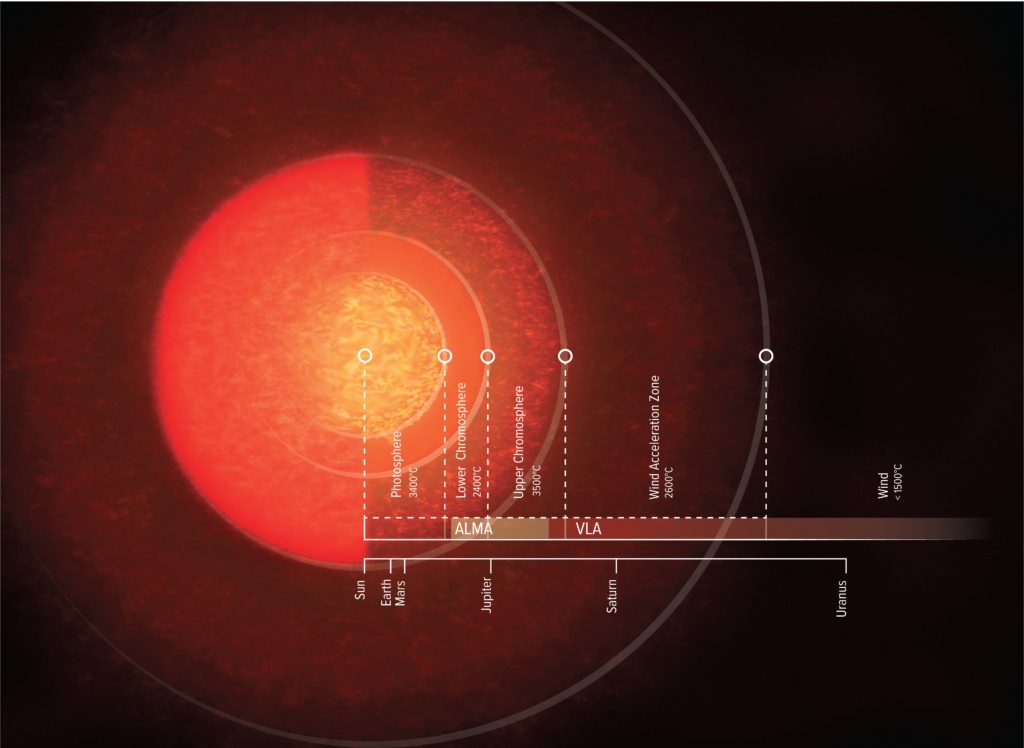Antares, the angry red eye of the constellation Taurus the bull, is a red supergiant star near the end of its life. And astronomers with the VLA and ALMA have realized that it’s much, much bigger than we ever imagined.
So when I say that Antares is a big star, I don’t think you really appreciate just how big it is. By mass it’s not the most impressive thing in the universe – just about a dozen times more massive than our sun. But Antares is in the late stages of its life cycle, running out of usable hydrogen in its core. The increasing presence of helium – the byproduct of hydrogen fusion – in the core pushes the hydrogen burning into a shell around it. This in turn inflates the rest of the star to grotesque proportions.
It’s a big star.

The photosphere, the layer of a star that emits visible light (and hence is the best working definition of “surface” that we can get when it comes to giant balls of plasma) is about 700 times wider that the sun. If placed inside our own solar system, the photosphere of Antares would engulf the planets Mercury, Venus, Earth, and even Mars, stretching to roughly the orbit of the asteroid belt.
And then it just keeps going.
Using combined high-resolution from the ALMA (Atacama Large Millimeter Array) and the Karl G. Jansky Very Large Array (VLA), astronomers determined that the atmosphere of that bloated star stretches far bigger than it reasonable ought to.
The first layer of a star’s atmosphere is called the chromosphere. In the sun, the chromosphere is a bare sliver hugging close to the photosphere, a mere half a percent of the sun’s radius. But in Antares, the chromosphere reaches dizzying heights, stretching to 2.5 the radius of the star itself. What’s more, the chromosphere of Antares is broken up into two discrete regions, and is relatively cool with a temperature of 3,500 Celsius. Compare that to the scorching 20,000 Celsius chromosphere of the sun, and you can appreciate that while Antares is massive, it’s not necessarily ferocious.
Did I mention that if you plopped Antares into our own solar system, its chromosphere would reach to nearly the orbit of Saturn?
Yeah, big.
Past the chromosphere, Antares gets even more strange. Stretching twelve times the diameter of the star (enough to reach Uranus in our own system), Antares sports a vast region that serves to accelerate particles faster than the star’s escape velocity, launching winds that leave the system altogether.
Those winds carry the beginnings of what will eventually become a vast and magnificent nebula, once Antares is done with being a star.
We don’t know a lot about these wind-launching regions. And as you might imagine, the same processes in the sun are just a tad bit weaker. By studying large, close stars like Antares better, astronomers can better understand how exactly massive stars die and prepare themselves to recycle into the next generation.


Antares is in Scorpio Paul not Taurus … but then is this article referring to Antares or Aldebaran? Surely Antares will go supernova not nebula? But if it Aldebaran why the super giant? Aldebaran is a giant star. Its all rather confusing but at least it allows us folks on the intellectual fringes to look clever 🙂
Yeah, Antares is in Scorpius and it should go supernova due to its mass of about 12 solar masses. Still there will be quite a bit of mass ejection before it does blow up and it will leave a nebula remnant like the Crab Nebula.
Of course yes, thank you David